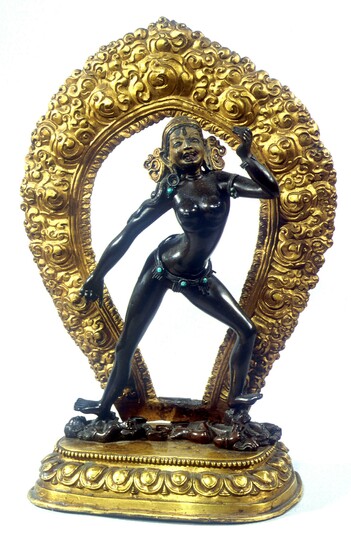
Item: Vajrayogini (Buddhist Deity) - (Naropa Tradition)
| Origin Location | China |
|---|---|
| Date Range | 1700 - 1799 |
| Lineages | Sakya, Gelug and Buddhist |
| Size | 31.50cm (12.40in) high |
| Material | Metal, Painted Face/Hair, Stone Inset: Turquoise |
| Collection | Rubin Museum of Art |
Classification: Deity
Appearance: Semi-Peaceful
Gender: Female
Vajrayogini, the 'Khechari of Naropa' (Tibetan: dor je nal jor ma, na ro kha cho ma). Belonging to the Chakrasamvara collection of Tantras and one of the five principal tantric practices of the Sakya School. Bibliographic reference: Laghusamvara Nama.
Sanskrit: Vajrayogini Tibetan: Dor je nal jor ma
Tibetan: Dor je nal jor ma
Sanskrit:  Tibetan:
Tibetan: 
"...Vajrayogini, on a multi-coloured lotus and sun seat, with the right foot extended pressing down on the breasts of red Kalaratri, left pressing on the backward bent head of black Bhairava. With a body red in colour, brilliant, like the fire at an aeon's end, one face, two hands, three eyes gazing at the pure [realm] of Khechara. The right hand holds a vajra marked curved knife extended downward, left, a blood filled skullcup held above with the face looking upward and drinking. On the left shoulder is a vajra marked katvanga with a damaru [drum], bell and three hanging pendants. Black hair in strands extends to the waist, youthful and with large breasts of desire, in a mood generating bliss. Having a crown of five dry human skulls and a necklace of fifty; naked, adorned with five mudras; Vairochana as a crown; standing in the middle of a blazing fire of pristine awareness." (Nesarwa Ngagwang Kunga Lekpai Jungne, 1704-1761).
Vajrayogini, is a representation of complete buddhahood in female form. Classified as Wisdom or 'Mother' Anuttarayoga Tantra the practices originate with the Chakrasamvara Cycle of Tantras. Although found in a variety of forms, she is common to all schools of Tibetan Buddhism. In this particular form she is a special teaching passed down from the lineage of the Indian mahasiddha Naropa through to the Sakya School. This form is also popular within the Gelugpa Tradition.
Lineage of Teachers: Vajradhara, Vajrayogini, Mahasiddha Naropa, Pamtingpa, Sherab Tseg, Mal Lotsawa, Sachen Kunga Nyingpo, Sonam Tsemo, Dragpa Gyaltsen, Sakya Pandita, Chogyal Pagpa, Konchog Pal, and Choje Dragpupa, Sonam Gyaltsen, Palden Tsultrim, Yeshe Gyaltsen, Kunga Zangpo, Konchog Gyaltsen, Sonam Sengge, Sanggye Rinchen, Lhachog Sengge, Konchog Lhundrub, Buddha Simha, Namkha Palzang, Sonam Lhundrup, Kunga Tashi, Sherab Jungne, Palchog Gyaltsen, Damcho Samdrup, Sanggye Phuntsok, Tashi Lhundrup, Tenzin Lhundrup, Palden Chogyong, Rinchen Tsogdrup, Namkha Chime, Kunga Tenzin, Jampal Zangpo, Khyentse Wangpo (1820-1892), Loter Wangpo, Chokyi Nyima, Shenpen Nyingpo, etc.
Jeff Watt 9-2005
Exhibition: Female Buddhas at RMA
Thematic Sets
Buddhist Deity: Vajrayogini Sculpture
Buddhist Deity: Vajrayogini, Khechara Iconography
Buddhist Deity: Vajrayogini, Khechara (Naropa Tradition)
Collection of RMA: Selected Sculpture
Collection of Jourdan-Barry
Buddhist Deity: Vajrayogini, Khechara (Naked Form)
Buddhist Deity: Vajrayogini, Khechara (Naropa Tradition) Sculpture Masterworks
Buddhist Deity: Vajrayogini Art History
Buddhist Deity: Vajrayogini Main Page
Collection of Rubin Museum of Art: Sculpture (Gallery 1)
